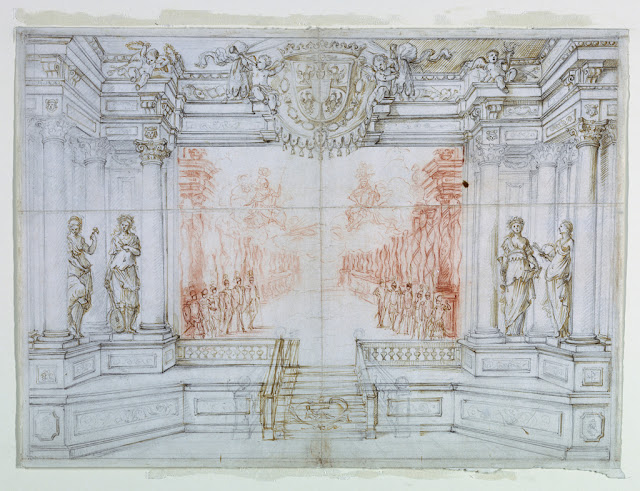 |
| Anonymous artist Sketch for wall decoration ca. 1800 drawing Cooper Hewitt, Smithsonian Design Museum |
 |
| Anonymous artist Design for painted ceiling and short wall ca. 1630-50 drawing Cooper Hewitt, Smithsonian Design Museum |
 |
| Anonymous artist Design for Theater Boxes ca. 1800-1900 drawing Cooper Hewitt, Smithsonian Design Museum |
"He searched among his gramophone records. No hi-fi system: only a great many lovingly-chosen discs. 'I'm going to play you something very fine, a new recording of L'Incoronazione di Poppea.' Laurence tried hard to concentrate. A woman was saying farewell to her country and her friends. It was beautiful. She looked at her father: oh to be able to sink into oneself like that. He alone possessed what she thought she had found in Jean-Charles and Lucien: upon his face there was a reflection of the infinite. To be delightful company for oneself: to be a hearth that sends out warmth. I indulge in the luxury of remorse: I blame myself for my neglect: but it is I who need him. She looked at her father: she wondered where his secret lay and whether she would ever be able to discover it. She did not listen. For a long while now music had no longer said anything to her. Monteverdi's pathos, the tragic utterances of Beethoven, referred to pains of a kind that she had never felt – huge, vehement, mastered pains. She had experienced a piercing anguish now and then, a certain wretchedness of mind, forlornness, perturbation, emptiness, boredom – above all boredom. No one celebrates boredom in music. 'Yes, it's perfectly splendid,' she said fervently. (Say what you think, said Mlle Houchet. Even with her father it was impossible. You say what people expect you to say.)"
– Simone de Beauvoir, from Les Belles Images (Gallimard, 1966), translated by Patrick O'Brian (1968)
 |
| Giuseppe Barberi Stage Design - Palace Architecture ca. 1775-1800 drawing Cooper Hewitt, Smithsonian Design Museum |
 |
| Anonymous Italian artist Stage Design - Garden Pavilion ca. 1775-1800 drawing Cooper Hewitt, Smithsonian Design Museum |
 |
| Anonymous Italian artist Stage Design - Staircases ca. 1800-1825 drawing Cooper Hewitt, Smithsonian Design Museum |
 |
| Jean Le Pautre Scene from a Tragedy ca. 1650 etching Cooper Hewitt, Smithsonian Design Museum |
"Hesitation with regard to the modern projects mainly has to do with a growing disbelief in their promises. Classical modernity believed in the ability of the future to realize the promises of past and present – even after the death of God, even after the loss of faith in the immortality of the soul. The notion of a permanent art collection says it all: archive, library and museum promised secular permanency, a material infinitude that substituted for the religious promise of resurrection and eternal life. During the period of modernity, the 'body of work' replaced the soul as the potentially immortal part of the Self. . . . But today, this promise of an infinite future holding the results of our work has lost its plausibility. Museums have become the sites of temporary exhibitions rather than spaces for permanent collections. The future is ever newly planned – the permanent change of cultural trends and fashions makes any promise of a stable future for an artwork or a political project improbable."
– Boris Groys, from Comrades of Time (2009)
 |
| Romolo Achille Liverani Stage Design - Interior of Circular Building ca. 1800-1825 drawing Cooper Hewitt, Smithsonian Design Museum |
 |
| Giuseppe Maria Mitelli Stage Design for Ballet 1675 drawing Cooper Hewitt, Smithsonian Design Museum |
 |
| Giovanni Piancastelli Stage Design - Vaulted Interior ca. 1675-1700 drawing Cooper Hewitt, Smithsonian Design Museum |
 |
| Angelo Toselli Stage Design - Palace Interior ca. 1815-30 watercolor Cooper Hewitt, Smithsonian Design Museum |
"Worldly realism knows nothing of truth: it is wholly absorbed in deliberating between greater and lesser 'evils', which is to say that it moves entirely within corruption, employing corrupt means in pursuit of corrupt ends. Such are the 'mechanisms of power' with which we are encouraged to acquaint ourselves. The cold world is the world in which these mechanisms are shown to be incapable of upholding a truth, but to operate rather through a kind of generalized power of falsity. It is not the world as it really is, but the un-world in which 'the thing which is not' stands exposed in its lack of being."
– Dominic Fox, from Cold World: the Aesthetics of Dejection and the Politics of Militant Dysphoria (Zero Books, 2009)
 |
| Angelo Toselli Stage Design - View into Palace Courts ca. 1820 drawing Cooper Hewitt, Smithsonian Design Museum |
 |
| Anonymous artist Stage Design - Figures Rushing into Crypt ca. 1775 drawing Cooper Hewitt, Smithsonian Design Museum |
 |
| Anonymous Italian artist Stage Design - Stone Interior with Staircase ca. 1800-1825 drawing Cooper Hewitt, Smithsonian Design Museum |